
A hairstyle, hairdo, haircut or coiffure refers to the styling of hair, usually on the human head but sometimes on the face or body. The fashioning of hair can be considered an aspect of personal grooming, fashion, and cosmetics, although practical, cultural, and popular considerations also influence some hairstyles.
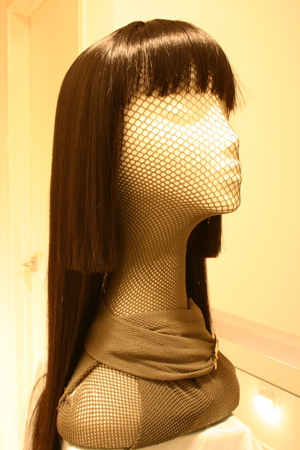
A wig is a head covering made from human or animal hair, or a synthetic imitation thereof. The word is short for "periwig". Wigs may be worn to disguise baldness, to alter the wearer's appearance, or as part of certain professional uniforms.

A turban is a type of headwear based on cloth winding. Featuring many variations, it is worn as customary headwear by people of various cultures. Communities with prominent turban-wearing traditions can be found in the Indian subcontinent, Southeast Asia, the Middle East, the Balkans, the Caucasus, Central Asia, North Africa, West Africa, East Africa, and amongst some Turkic peoples in Russia.
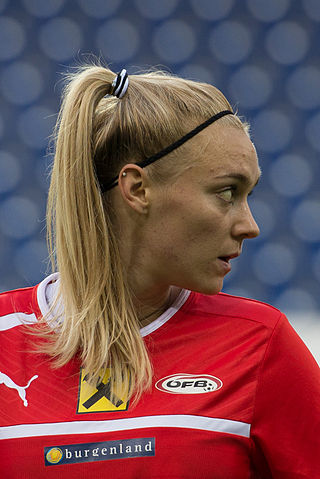
A ponytail is a hairstyle in which some, most, or all of the hair on the head is pulled away from the face, gathered and secured at the back of the head with a hair tie, clip, or other similar accessory and allowed to hang freely from that point. It gets its name from its resemblance to the tail of a pony.

The chonmage (丁髷) is a type of traditional Japanese topknot haircut worn by men. It is most commonly associated with the Edo period (1603–1868) and samurai, and in recent times with sumo wrestlers. It was originally a method of using hair to hold a samurai kabuto helmet steady atop the head in battle, and became a status symbol among Japanese society.
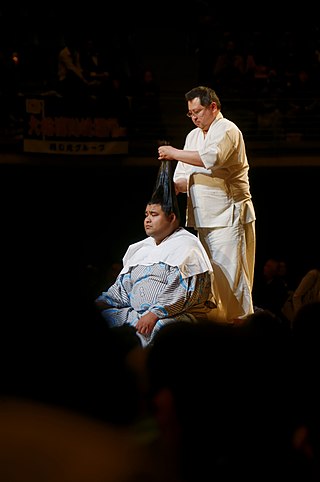
A tokoyama (床山) is a traditional Japanese hairdresser specializing in the theatrical arts and professional sumo. The tokoyama trade is the result of a slow evolution from the traditional Japanese barbers of the Edo period, some of whom gradually started to specialize in hairstyles of actors, puppets, and rikishi. The word tokoyama uses a Japanese character meaning 'floor', because in the Edo period barbers had shops on simple raised floors.

In the context of hairstyles, the usage of the term pigtail shows considerable variation. The term may refer to a single braid, but is more frequently used in the plural ("pigtails") to refer to twin braids on opposite sides of the head. Sometimes, the term "pigtails" applies whether or not the hair is braided, but there is not widespread agreement on this.

Fashion in the years 1750–1775 in European countries and the colonial Americas was characterised by greater abundance, elaboration and intricacy in clothing designs, loved by the Rococo artistic trends of the period. The French and English styles of fashion were very different from one another. French style was defined by elaborate court dress, colourful and rich in decoration, worn by such iconic fashion figures as Marie Antoinette.

Fashion in the period 1795–1820 in European and European-influenced countries saw the final triumph of undress or informal styles over the brocades, lace, periwigs and powder of the earlier 18th century. In the aftermath of the French Revolution, no one wanted to appear to be a member of the French aristocracy, and people began using clothing more as a form of individual expression of the true self than as a pure indication of social status. As a result, the shifts that occurred in fashion at the turn of the 19th century granted the opportunity to present new public identities that also provided insights into their private selves. Katherine Aaslestad indicates how "fashion, embodying new social values, emerged as a key site of confrontation between tradition and change."
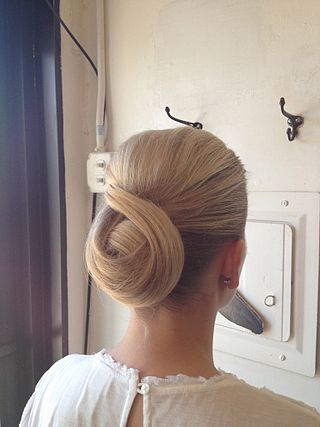
A chignon, from the French chignon meaning a bun, is a hairstyle characterized by wrapped hair on the back of the head. In the United States and United Kingdom, it is often used as an abbreviation of the French phrase chignon du cou, signifying a low bun worn at the nape of the neck.

A queue or cue is a hairstyle worn by the Jurchen and Manchu peoples of Manchuria, and was later required to be worn by male subjects of Qing China. Hair on top of the scalp is grown long and is often braided, while the front portion of the head is shaved. The distinctive hairstyle led to its wearers being targeted during anti-Chinese riots in Australia and the United States.
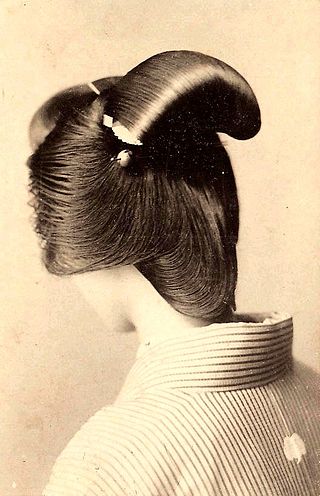
Nihongami is the term used for a number of traditional Japanese hairstyles considered to be distinctive in their construction and societal role.

Khmer traditional clothing refers to the traditional styles of dress worn by the Khmer people throughout history. Tracing their origins back to the early Common Era, the customary styles of dress worn by Khmer people predate the indianization of Southeast Asia. The evolution of these clothing customs can be traced through archaeological artifacts from the 6th century to the post-Angkorian period, evolving from the simple pre-Angkorian Sampot to vibrant and intricately embroidered silk garments. Khmer traditional costumes are nowadays mainly worn for celebrations, reflecting a strong sense of national identity.

Short hair refers to any haircut with little length. It may vary from above the ears to below the chin. If a man's hair reaches the chin, it may not be considered short. For a woman, however, short varies from close-cropped to just above the shoulders. This varies from culture to culture, in more traditional societies in Eastern Europe, Asia, and the Islamic world, short hair on women means anything shorter than chest length with chest length to elbow length being considered medium-length. However, among more progressive societies with far less structured gender norms, the classic bob is considered medium-length with "short hair" referring to pixie cuts and similar hairstyles. Different styles of short hair include the bob cut, the crop and the pixie cut.

Hairstyle fashion in Rome was ever changing, and particularly in the Roman Imperial Period there were a number of different ways to style hair. As with clothes, there were several hairstyles that were limited to certain people in ancient society. Styles are so distinctive they allow scholars today to create a chronology of Roman portraiture and art; we are able to date pictures of the empresses on coins or identify busts depending on their hairstyles.

Headgear, headwear, or headdress is any element of clothing which is worn on one's head, including hats, helmets, turbans and many other types. Headgear is worn for many purposes, including protection against the elements, decoration, or for religious or cultural reasons, including social conventions.
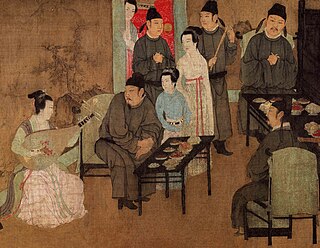
Hanfu, are the traditional styles of clothing worn by the Han Chinese since the 2nd millenium BCE. There are several representative styles of hanfu, such as the ruqun, the aoqun, the beizi and the shenyi, and the shanku.

Braids are a complex hairstyle formed by interlacing three or more strands of hair. Braiding has been used to style and ornament human and animal hair for thousands of years in various cultures around the world.

The sangtu (Korean: 상투) was a Korean topknot hairstyle worn by Joseon married men.





















